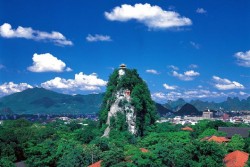You have no items in your shopping cart.


Introducing Fubo Hill
Named after General Fubo of the Han dynasty, Fubo Hill stands overlooking Guilin city. Also known as Wave Subduing Hill, Fubo Hill is 120 metres long, 60 metres wide and 213 metres high. Located on the west bank of Li River, it's half submerged yet still standing elegantly over the river. Fubo Hill is blessed with natural beauty and is a pleasant inclusion on any Guilin Tour.
Fubo Hill Fast Facts
• Chinese Name: Fuboshan 伏波山
• Best Time to Visit: April to November
• Recommended Visiting Hours: About 1 to 2 hours
• Things to Do: Photography, Nature, Hiking
• Opening Hours: 06:00-18:30 from Apr to Nov; 07:00-18:00 from Dec to Mar
• Entrance Fee: ¥22
• Address: No. 27 Binjiang Road, Diecai District, Guilin, Guangxi Zhuang Autonomous Region
What to expect at Fubo Hill
Natural scenery of rocks and stalactites as well as artificial cloister and pavilions compose the fantastic and unique sight of Fubo Hill. At the foot of the hill lie the Pearl-Returning Cave, the Thousand-Buddha Cave and the Sword-Testing Rock, all of which have great appeal. A gracious cloister and tearoom were built on the southern slope. Halfway to Fubo Hill is the Tingtao Pavilion (Pavilion of Listen-to-Waves). Stone stairs wind up towards the hilltop on the western slope of Fubo Hill. The Viewing Platform on the stairway is an ideal spot for taking in the panorama of Guilin.
Entering the cave by boat on the green Fubo River, visitors are given the opportunity to appreciate the charming rock and stalactites and the interior statues. Most of the statues were engraved in the later Tang Dynasty by use of finished techniques, and subsequently became precious Buddhist artworks.
There are many different and interesting legends about the Pearl-Returning Cave. One of them tells that after the triumph of war, General Fubo retreated to the court, bringing herbs by boat. However, on the way, he was framed so as to have wringed pearls put in the boat. To clear the matter, he poured all the herbs into the Fubo River and returned the so-called 'pearls'. Hence, the cave was named 'Pearl-Returning Cave'.
Another legend suggests that a peasant picked a great glittering pearl from the cave and angered the Dragon King. The peasant's neighbors advised him to return the pearl at once, and so he did. Thus, the Dragon King stopped raising the devil waves, and humans' lives became peaceful once more. To memorize the event, people entitled the cave 'Pearl-Returning'.
Connecting with the Pearl-Returning Cave, the Thousand-Buddha Cave lies hidden in Fubo Hill. It has three levels with a total area of 133 square meters (159 square yards). Visitors climbing up along the winding stairs will find themselves attracted to the 239 statues of Buddha in 36 enshrines from the later Tang Dynasty situated on the upper level, along with mural paintings from the Song Dynasty (960-1279). All of the artworks bear exquisite carvings. Among them, a curiosity can be found - a painting of Mi Fu, a renowned artist, done by the artist himself, because few of Mi Fu's works are intact today.
How to get to Fubo Hill
• Take bus No. 2, 203, 206, Tourist Line 1 or 2 and get off at Fuboshan Station.
Additional travel advice on Fubo Hill
• Please wear comfortable walking shoes.